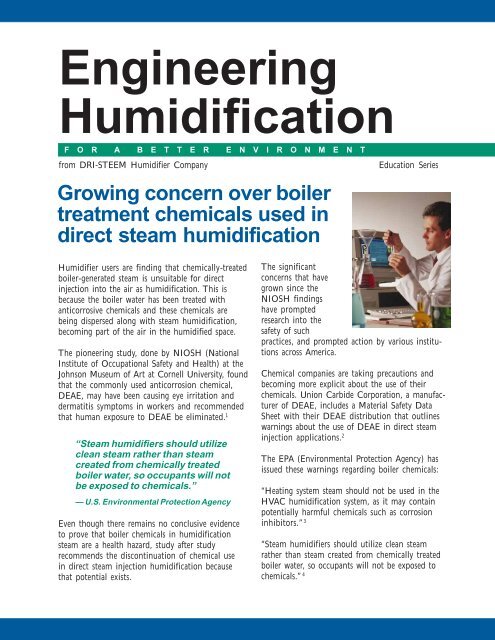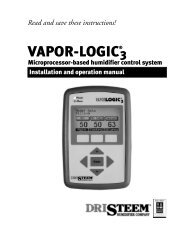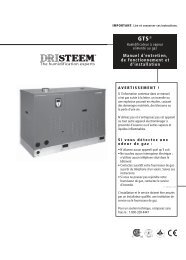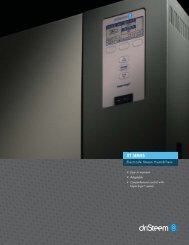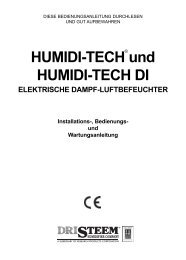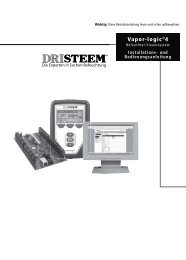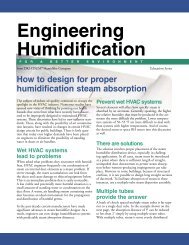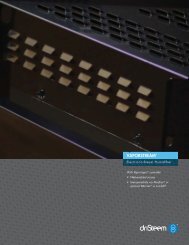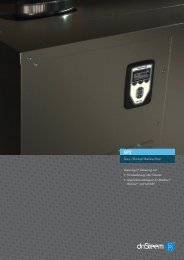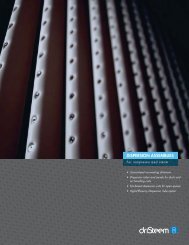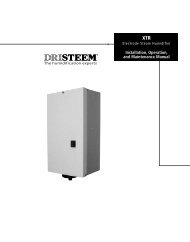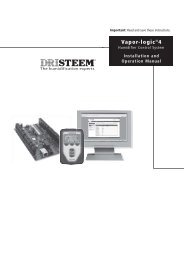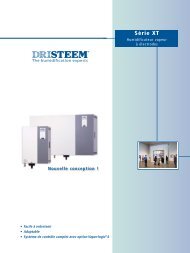Engineering Humidification - DRI-STEEM
Engineering Humidification - DRI-STEEM
Engineering Humidification - DRI-STEEM
Create successful ePaper yourself
Turn your PDF publications into a flip-book with our unique Google optimized e-Paper software.
<strong>Engineering</strong><strong>Humidification</strong>F O R A B E T T E R E N V I R O N M E N Tfrom <strong>DRI</strong>-<strong>STEEM</strong> Humidifier CompanyGrowing concern over boilertreatment chemicals used indirect steam humidificationEducation SeriesHumidifier users are finding that chemically-treatedboiler-generated steam is unsuitable for directinjection into the air as humidification. This isbecause the boiler water has been treated withanticorrosive chemicals and these chemicals arebeing dispersed along with steam humidification,becoming part of the air in the humidified space.The pioneering study, done by NIOSH (NationalInstitute of Occupational Safety and Health) at theJohnson Museum of Art at Cornell University, foundthat the commonly used anticorrosion chemical,DEAE, may have been causing eye irritation anddermatitis symptoms in workers and recommendedthat human exposure to DEAE be eliminated. 1“Steam humidifiers should utilizeclean steam rather than steamcreated from chemically treatedboiler water, so occupants will notbe exposed to chemicals.”— U.S. Environmental Protection AgencyEven though there remains no conclusive evidenceto prove that boiler chemicals in humidificationsteam are a health hazard, study after studyrecommends the discontinuation of chemical usein direct steam injection humidification becausethat potential exists.The significantconcerns that havegrown since theNIOSH findingshave promptedresearch into thesafety of suchpractices, and prompted action by various institutionsacross America.Chemical companies are taking precautions andbecoming more explicit about the use of theirchemicals. Union Carbide Corporation, a manufacturerof DEAE, includes a Material Safety DataSheet with their DEAE distribution that outlineswarnings about the use of DEAE in direct steaminjection applications. 2The EPA (Environmental Protection Agency) hasissued these warnings regarding boiler chemicals:“Heating system steam should not be used in theHVAC humidification system, as it may containpotentially harmful chemicals such as corrosioninhibitors.” 3“Steam humidifiers should utilize clean steamrather than steam created from chemically treatedboiler water, so occupants will not be exposed tochemicals.” 4
In March of 1994, the California Office of StatewideHealth Planning and Development released a CodeApplication Notice that stated: “If steam from acentral boiler plant will be injected into the airstream,the design professional should verify that theboiler water will not be treated with chemicals orcontain minerals which are known to be hazardousto health, or which might contribute to an indoorair quality problem.”While the wait continues for conclusive evidencethat proves the specific hazards of boiler chemicalsused in direct steam humidification, preventativemeasures are already being taken among HVACengineers and building owners, in institutions asvaried as hospitals, office buildings and museums.How boiler treatmentchemicals workTo ensure an acceptable service life for steam boilers,condensate piping and all associated components,protection from corrosion is provided through theuse of boiler water treatment chemicals. Heattransfer surfaces, such as boiler tubes, are alsoprotected against buildups of oxides and mineralsthat could cause overheating and heat transferfailures.How corrosion occursCorrosion occurs in a condensate system as a result ofcarbon dioxide and oxygen dissolving in condensate.How boiler chemicals enter the airstreamCitywaterDuctReturnwaterèèèHumidifierèFeedwaterChemicalladenairChemicallytreated steamèèèBoilerDissolved carbon dioxide forms carbonic acid.The carbon dioxide in the system results primarilyfrom carbon compounds in the feed water beingthermally broken down in the boiler.Oxygen enters the system through vents, steamtraps, or air leaks. Dissolved oxygen usually causeslocalized pitting, while carbonic acid continuallyerodes and causes ruts or troughs to form at thebottom of condensate pipes.Ammonia is a third contributor to corrosion.By combining with oxygen, it forms ammoniumhydroxide, which attacks copper and brass partsin the system.Boiler chemicals reduce corrosionAmines are alkaline compounds added to boiler feedwater to neutralize the effects of carbonic acid.Amines are vaporized in the boiler and are carried asa gas along with the steam. To ensure that all partsof the piping system receive protection, severaldifferent amines (each having different condensingrates) are often blended together.Cyclohexylamine is slow to condense and thereforeprotects the far ends of the system. Diethylaminoethanol(DEAE) works on the mid-length runs,while morpholine takes care of the short runsbecause it condenses earliest.Sometimes carbon dioxide concentrations are sohigh that neutralization is impractical. In thosecases a filming amine, such as octadecylamine, isadded. This amine provides a protective film on thevulnerable metal surfaces to prevent oxygen and acidcorrosion.Chemicals in air cause irritationWhen used in conjunction with direct steaminjection humidifiers, boiler chemicals come incontact with humans. Amines irritate eyes and skin,and aggravate respiratory ailments. Some may alsocombine with other substances to form carcinogeniccompounds. In addition, amines can negativelyaffect the preservation of certain organic materials.As a result, institutions like museums and artgalleries, as well as hospitals and office buildings,are replacing direct boiler steam injection with analternative method of humidification.
Alternatives:Use boiler steam, but keepchemicals out of the airSteam-to-steam converter systemA steam-to-steam converter system (drawing, right)is one way to take advantage of on-site steam whilecreating very pure humidification steam. Instead ofinjecting boiler-generated steam directly into theairstream, boiler steam is used as an energy source toheat a second pressurized vessel filled with deionizedwater, creating ultra-pure steam for humidification.This system offers flexible design, easy installationand superior control capability, and the use ofindividual, compact, duct-type steam injectionhumidifiers that allow individual room or zonecontrol. Although this method is highly successful,the use of deionized water requires that the humidifierand valves be fabricated completely in stainlesssteel. Therefore, this system is used in applicationswhere superior control, high-purity steam, andmaintenance-free humidification take high priorityto justify the higher cost.Steam-to-steam evaporative humidifierAnother way to take advantage of on-site steam is torun boiler steam through the heat exchanger of anevaporative humidifier tank (see drawing below).This steam-to-steam system is a cost-effective way toprovide humidification free of boiler chemicals whileusing on-site boiler steam as the energy source.Steam-to-steam converter systemSteam-to-steamconverterHumidifiersBoilerIn this system, boiler steam is sent to a steamto-steamconverter where secondary, pressurizedsteam is generated and then delivered tosteam injection humidifiers.Evaporative steam-to-steam systems can use tap,softened or DI/RO (deionized/reverse osmosis)makeup water, offering a range of solutions to meetalmost any humidification need. Systems usingDI/RO makeup water provide the tightest control,the cleanest humidification steam and require almostno maintenance, but also require higher qualityequipment. Standard water systems use either hardtap or softened water, with water level controlsystems designed to skim or flush precipitatedminerals. Systems using softened water can operatefor several seasons without a need for cleaning.Steam-to-steam evaporative humidifierPrinciple of operation:„1. Makeup water enters the evaporating chamberthrough the automatic water makeup valve.2. Pressurized steam passes through themodulating steam valve to the heat exchanger.Here it causes water in the chamber to boilcreating secondary, evaporative steam forhumidification.‚3. Condensate from the heat exchanger passesthrough a steam trap and is returned to the boiler.ƒ4. <strong>Humidification</strong> steam is dispersed into theairstream.
Chemical-free steam with <strong>DRI</strong>-<strong>STEEM</strong>’s STS ®No direct injection of boiler chemicals!Consider the benefits of an evaporativesteam-to-steam humidification system:• Economical• VAPOR-LOGIC3 state-of-the-art control• Redesigned cover and cleanout plate easemaintenance• RH control to ±3%• Maximum capacity to 6400 lbs/hr• Designed for use with all types of makeup water:tap, softened or DI/RO• Disperse steam through ductwork or directlyinto a space• CLEAN humidification steam!Visit the on-line humidification resource centerCheck out our web site to learn more about designing humidification systems, types ofhumidifiers and current humidification issues. You'll find our newest tool, the Design Guidemanual to help you design and specify a humidification system. Also available on our web siteis <strong>DRI</strong>-CALC ® — our exclusive software that sizes loads, selects equipment, writesspecifications, and creates equipment schedules for <strong>DRI</strong>-<strong>STEEM</strong> products.www.dristeem.comNotes:1. NIOSH Health Hazard Evaluation Report, HETA Publication No. 83 020-1351, Cornell University, Ithaca, NY, August, 1983.2. Material Safety Data Sheet: MORLEX Corrosion Inhibitor DEEA, Union Carbide Chemicals and Plastics Company, Inc., August, 1993.3. EPA/400/1-91/033, December, 1991.4. EPA SN-005-000-00390, September, 1992.<strong>Engineering</strong> <strong>Humidification</strong> is published by:The <strong>DRI</strong>-<strong>STEEM</strong> representative in your area is:14949 Technology Drive • Eden Prairie, MN 55344Phone: (952) 949-2415 • Fax: (952) 229-3200E-Mail: sales@dristeem.com • Web: www.dristeem.com1-800-328-4447Europe Office:Bell Place, Bell Lane • Syresham, Brackley • NN13 5HP, U.K.Phone: +44 1280 850122Fax: +44 1280 850124E-Mail: 106277.1443@compuserve.comForm No. EH-Boiler Chemicals - 0703© 2003 <strong>DRI</strong>-<strong>STEEM</strong>


